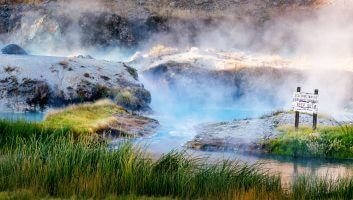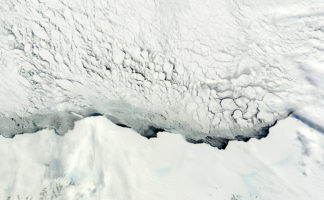Support Hidden Compass
Our articles are crafted by humans (not generative AI). Support Team Human with a contribution!
Just before dawn, the atmosphere along the Kalpitiya peninsula in western Sri Lanka is a deep, murky indigo. A team of about 15 fishermen has gathered at the shore, small waves lapping at their ankles. Together, they hoist their vallam — a boat shaped like a large canoe — inch by inch into the water, humming to keep cadence.
One man will take the vallam out to sea, leaving the other men to handle the net as he directs them farther into the water. From his vantage point, he can better guide them to their catch. Working together under his direction, they pull a single massive net — known as a seine — from both ends, encircling a school of fish.
There’s an art to reading the environment and deciding how to fish each day. The fishermen look to the weather, to the flocks of terns over the ocean’s surface, to the color of the water and its wave patterns. Each of these cues, taught to them by their fathers, helps these men predict where the fish may be, guiding them as they decide where and when to cast their nets.
This traditional style of fishing is communal and rooted in generational knowledge. Some researchers have described it as the nation’s “single most important form of fishing.” Known as “beach seining,” this work is at the heart of the very identity of these men. But it is a style of fishing that is rapidly becoming obsolete in Sri Lanka.
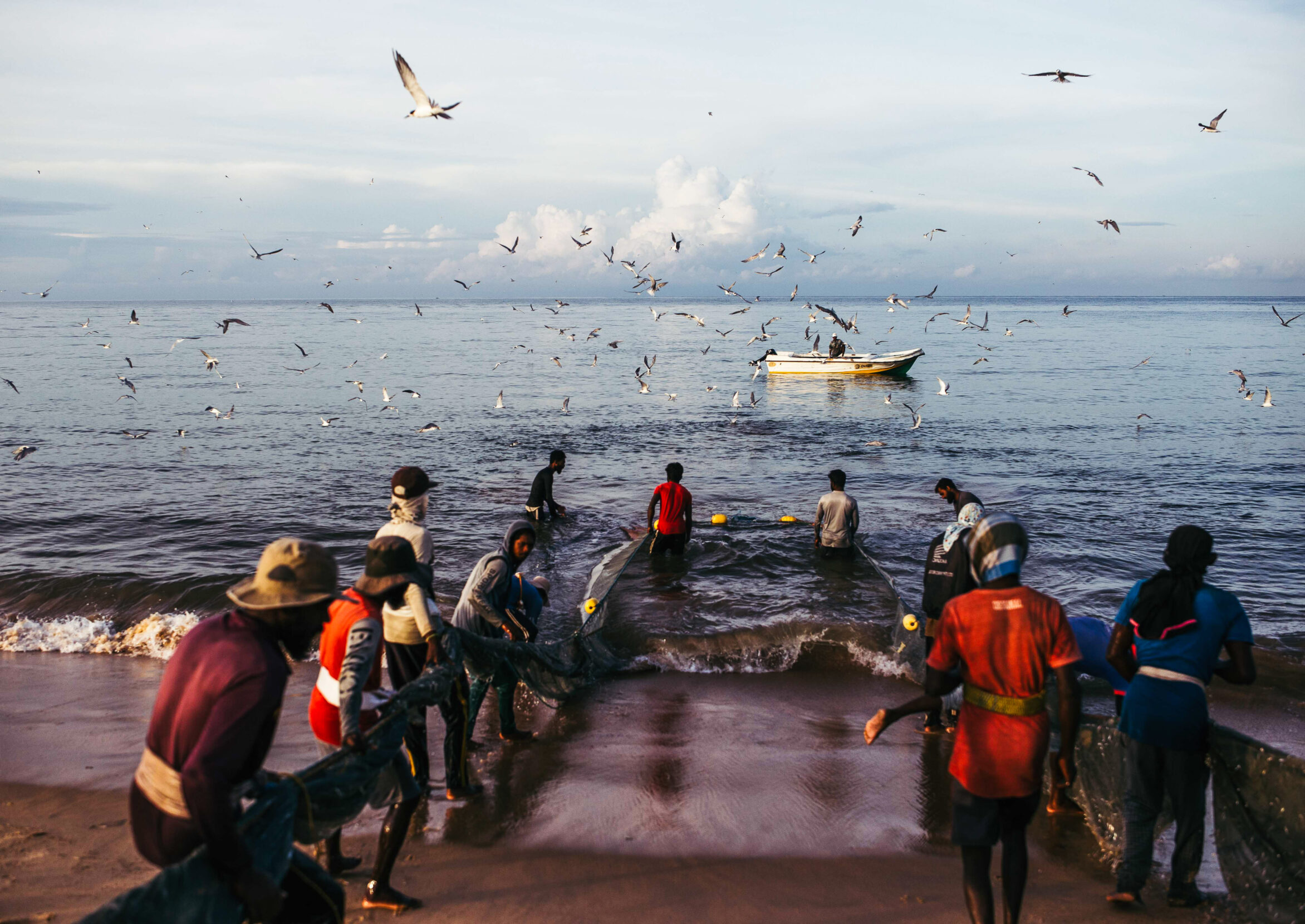
Beach seine fishing is a communal activity. In this case, one man goes out to sea and acts as a guide, while the others wade into the water, encircling the fish with the seine. Overhead, circling terns give clues about where the best catch may be. Photo: Kang-Chun Cheng.
Along the snaking coastline of this beautiful country, tessellated by glassy lagoons, mechanization has taken hold, altering both the practice of beach seining and the community’s approach to their work. Even here in Kalpitiya, where the work is primarily manual — the men haul in the net by the weight of their bodies — the vallam runs on kerosene.
Even the fishermen themselves operate like a single machine. There is hardly a word exchanged between the men, seven on each side of the net, the conductor in the vallam directing the crew on land from as far as a kilometer away. By the end of the haul, the men are waist-deep in the ocean, and the anchovies they’ve caught are a pulsing bulge against the net. The sun has risen by now, casting peachy light over everything, illuminating the transparency of the fine mesh seine.
The catch is sizable: nearly 100 kilograms of anchovies. Their gleaming bodies squirm in the bright morning light, the last dance of their lives. Banding around the net, the fishermen use short lengths of rope to gently beat the anchovies loose before pouring the silvery cascade into huge straw baskets.
The particulars of each beach seine — how many men it involves, what type of fish they target, and with what kind of seine, along with the division of catches and profit — vary by geography. However, all beach seines in Sri Lanka have one thing in common: They face turning tides on every front — economic, environmental, cultural, and existential.
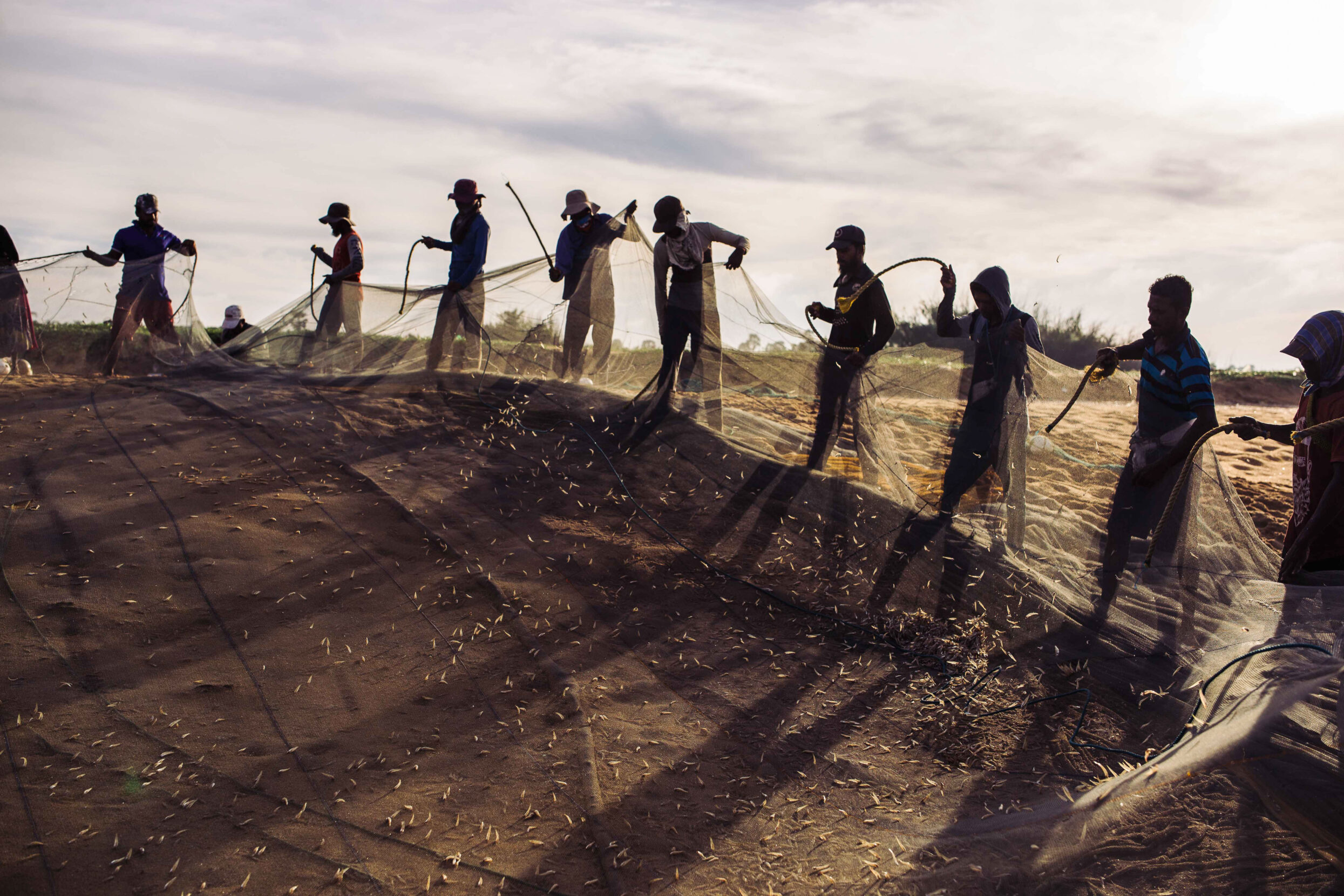
After bringing their catch ashore, fishermen work together to beat the fish loose from the net with pieces of rope. Photo: Kang-Chun Cheng.
~~
There’s something about fishing that has always fascinated me. The rhythm of the waves, being immersed in the blue of the water and the sky, and how attuned one must be to the surroundings for both safety and success — the balance of peace and vigilance.
In September 2022, I met a Sri Lankan marine biologist, Akila Harishchandra, at a party in rural Maine. I had been visiting friends on a climbing trip, and he was preparing to defend his dissertation in the spring. I mentioned that I would be visiting Sri Lanka on an upcoming trip from my home base in Kenya, and I expressed my interest in learning more about how small-scale fishermen are holding their ground amidst the swirling political and climatic changes. We kept in touch, and like magic, Harishchandra connected me to his former colleagues at Sri Lanka’s National Aquatic Resources Research and Development Agency (NARA). Now, just a few months later, I find myself walking along the seemingly boundless sand dunes of Negombo Lagoon in the western province.
Though I’m a stone’s throw from a stretch of beachside restaurants, the place is quite empty — chairs piled up at the back of closed establishments, sand creeping up the patios. Tourists have barely started to trickle back, but even before the pandemic, visitors had thinned out in the wake of terrorist attacks and civil unrest.
When I come across a fisherman named Marcus, sitting on a sandbar and mending nets with a few friends, I introduce myself.
Ever since he was a boy, Marcus has fished in Negombo Lagoon, fed by a tangle of small rivers and a canal on the southwestern shores of Sri Lanka. He heads out on his paddle boat to fish almost every day and, despite decades of toiling under the sun, looks slightly younger than his 52 years. In recent years, he tells me, the waves have been getting rougher and the work has become increasingly risky.
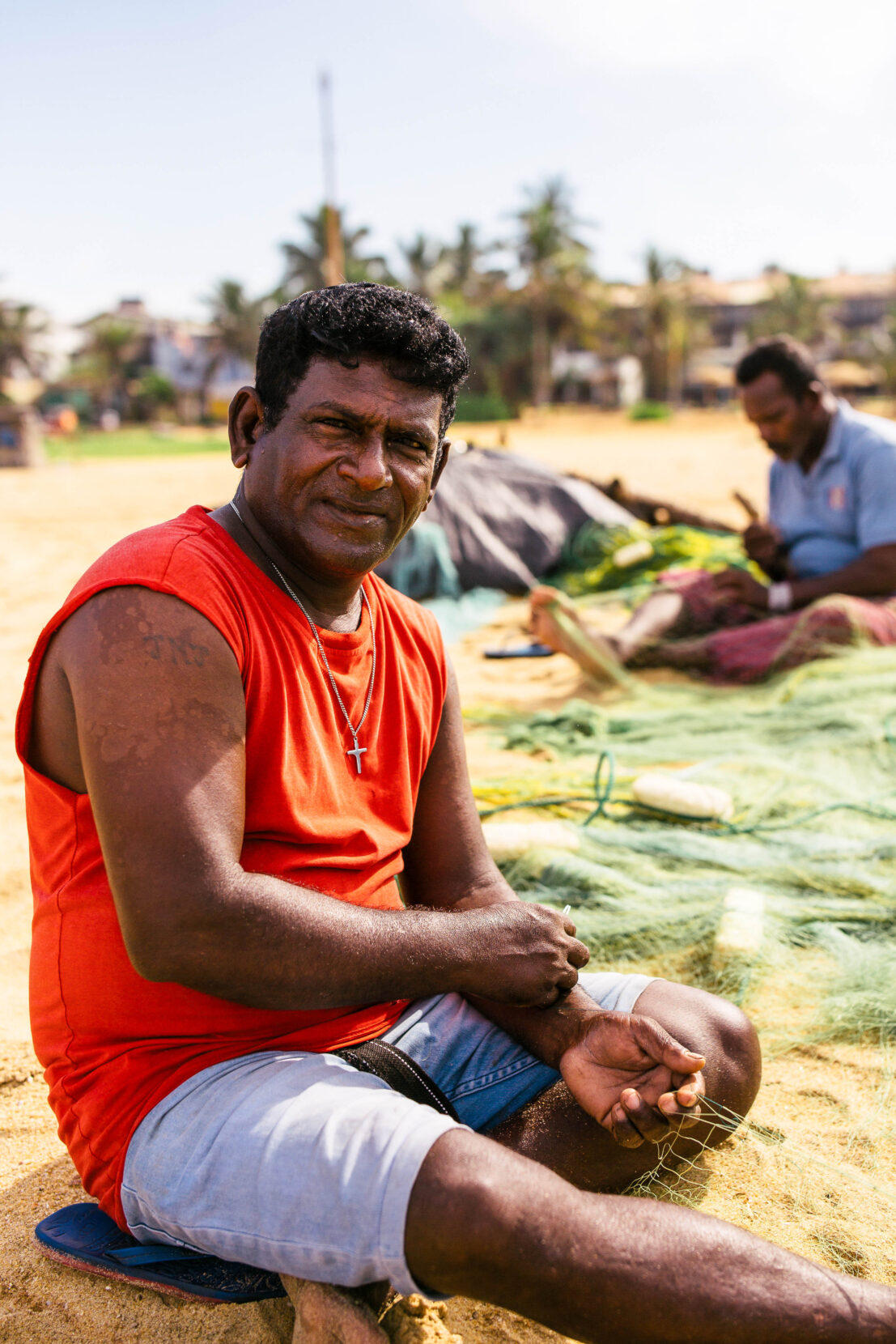
Marcus, aged 52, has been a fishing in the Negombo Lagoon since he was a child. Photo: Kang-Chun Cheng.
Marcus invites me to his home to meet his family, and we walk a few hundred meters inland to his cinder block house, where his wife, Maria, and their two grandchildren also reside. Their home is sparse; one of the few decorations in their sitting room is a sculpture of the Virgin Mary. It is offset by an ancient television.
As we chat, Maria serves me a steaming cup of ginger tea. I learn that their daughter died in a car accident, which is why they are raising her son and daughter. Through an open door, I see a baby blue mosquito net draped over the bed where the kids sleep. Later, in their backyard, shared with a few neighbors, the boy proudly shows me the rooster he is raising.
Marcus says he has a 24-year-old son who mostly line-fishes for work. “But he wants to do something different,” he continues. It is easy for young people to get antsy considering how difficult the job is and how little money it brings in, Marcus tells me.
Marcus isn’t the only one who sees this. With the ubiquity of mobile phones and easy internet access, young people expect a different life from their parents, believes Harishchandra, the marine biologist I met in Maine. “They see very different lifestyles across the globe that seem more appealing than fishing.” Many, he says, dream of going elsewhere.
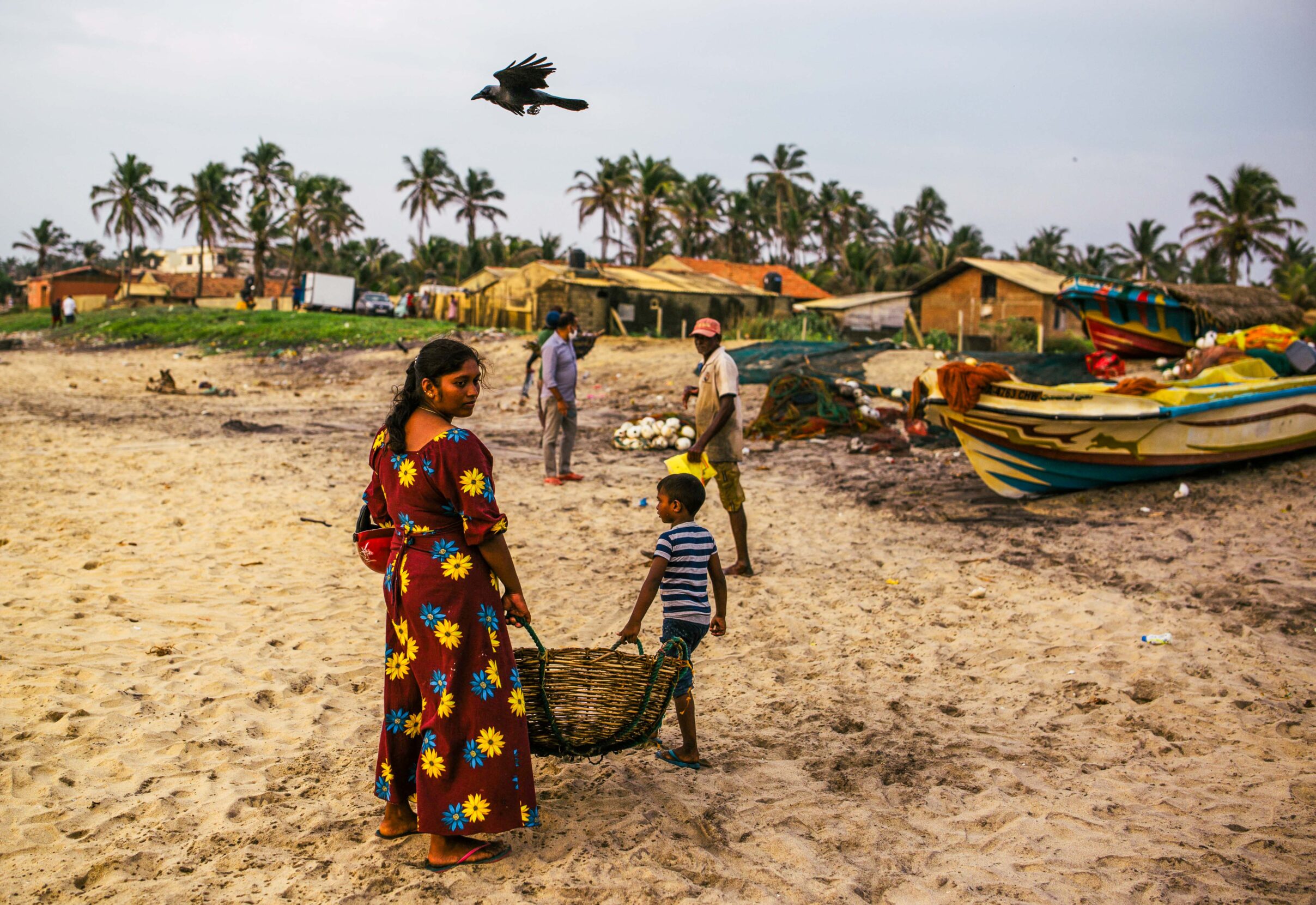
Seine fishing in Sri Lanka often involves the entire family. But younger generations are increasingly looking for a different way of life. Photo: Kang-Chun Cheng.
~~
In May 2021, the X-Press Pearl cargo ship burst into flames, sinking toxic chemicals and 1,680 metric tons of plastic pellets onto Sri Lanka’s shorelines. It happened just off the western coast, where fishermen, crab and clam hunters, and surfers work and live. In an instant, their paradise became an unrecognizable environmental crime scene as oil, hazardous chemicals, and plastics swirled ashore and even more waste sunk to the bottom of the ocean. Considered the worst maritime catastrophe in Sri Lanka’s history, the spill likely caused a spike in turtle and marine mammal deaths. To this day, the full ramifications of the X-Press Pearl accident are under-researched and, therefore, largely unknown.
The disaster mirrors what is happening all over the world: Weather-dependent livelihoods are becoming more challenging as oceans warm, fish stocks dwindle, and plastic waste chokes sea life to death. None of this has spared seine fishing communities.
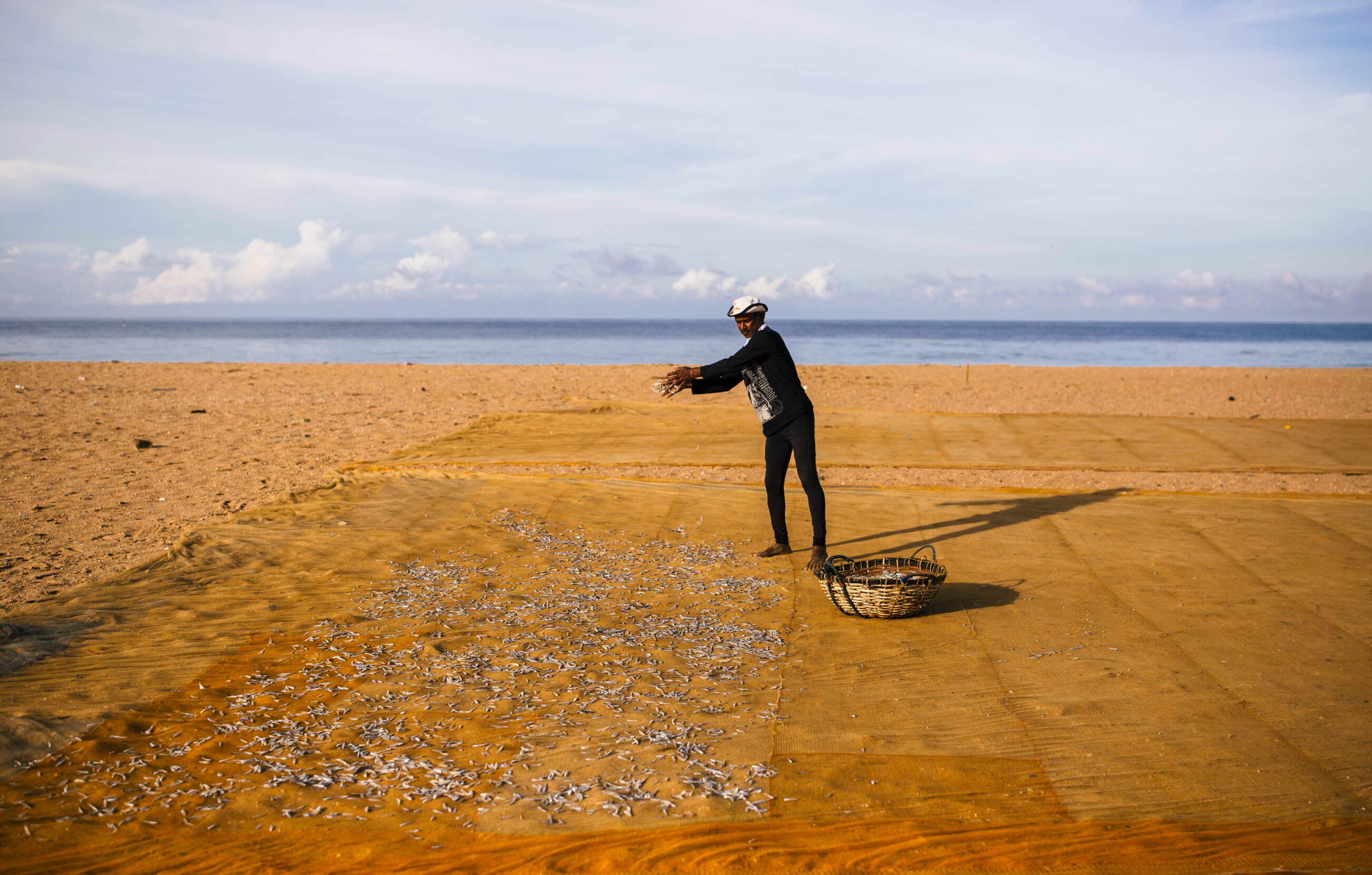
A fisherman lays out his catch to dry in the sun. In the face of climate change and other environmental disasters, seine fishing is just one of many livelihoods at risk. Photo: Kang-Chun Cheng.
Moreover, the nation is in the middle of its worst economic crisis to date, fueled by corruption, currency collapse, and years of myopic policies. The government owes more than $13 billion to foreign lenders as of January 2024, but that debt is in restructuring negotiations. The crisis has included unchecked inflation — the price of petrol more than tripled — food and medicine shortages, general despondency, and a rising desire to emigrate. Though everyone in Sri Lanka has suffered, people experiencing poverty have borne the brunt of the economic turmoil.
~~
Sri Lankans have a reputation for being incredibly friendly, but I am still floored by how willing the NARA team has been to help a random American journalist who has expressed interest in learning about Sri Lankan fishing traditions. Marine researcher K.P.G.L. Sandaruwan, jovial with a slight scruff, and two other members of his team have kindly offered to let me tag along. We spend nearly a week visiting lagoons along the western shore, wrapping up their season’s field research. Sandaruwan is newly married and just had a child. He proudly shows me a photo of his son on his phone.
The researchers have been visiting various beach seine fishermen along the coast, gathering information about impacts from the X-Press Pearl: Two years later, were they still dealing with ramifications from the spill?
Most fishermen they speak to are absorbed by the ongoing economic crisis. The cargo spill has faded into an afterthought. However, in Chilaw –– north of where we are by Negombo Lagoon –– some fishermen have found a jelly substance entangled in their nets, which are sticky with fuel and grease. It’s likely from the wreck, siphoned up with the monsoon patterns.
We talk on the drives from site to site, windows down in the extreme humidity. Sandaruwan tells me he was born and raised in Pinikaha, a tiny farming village in the south that grows cinnamon, rubber, and tea. Although he studied agricultural sciences, he pivoted to marine science after attending a talk by a fisheries economics professor.
When he partnered with British researchers from the University of Newcastle a few years ago, they examined Sri Lankan fisheries through a “well-being framework,” considering alcoholism, gender equity, and domestic violence –– social problems overlooked by marine policymakers and authorities. It is an unusual angle for Sri Lankan fisheries research. He’s an encyclopedia of cultural knowledge, information he shares generously with me.
Conversations about ‘living well’ helped community members communicate their life successes and challenges in their own words. Sandaruwan and his colleagues found that for women living with alcohol or domestic abuse in their homes, marine resources — like seine fishing — serve as a way out, bolstering their financial autonomy and bargaining power at home.
“I’d never even considered these issues before,” says Sandaruwan. He started to think about beach seine communities differently, from a more holistic light.
But life as a fisherman, he reflects, is a bit like gambling. “Sometimes you bring home a lot, other times, nothing.”
These days, with such drastic shifts in ecology and climate, catches seem more dependent on luck than ever. Beyond the overarching environmental, economic, and political obstacles, there are social and religious ones as well. Nevertheless, rather than solely posing a challenge, these elements may also hold the key to resilience.

A fisherman displays his catch of squid, still sandy after being pulled from the surf. Photo: Kang-Chun Cheng.
~~
Formerly known as Ceylon, Sri Lanka is just a skip southeast of India. Over centuries, the island nation echoed religious and cultural changes simmering within the subcontinent through trade and pilgrimages. Buddhism, ultimately woven into the nation’s consciousness, came to the nation through missionaries sent by Ashoka the Great, the last major ruler of the Mauryan Empire (321 to 185 BCE).
Today, more than half of Sri Lankans practice Buddhism. However, existing within a majority Buddhist society means fishermen invariably grapple with immense internal guilt. Fishing inherently violates a main tenet of Buddhism: never kill.
“It’s a long cycle since killing animals means that you’ll be punished in your next life,” explains Sandaruwan.
Fishermen will catch — and inevitably kill — fish, then feel guilted into going to temple to absolve themselves. By practicing the most obvious coastal livelihood, many Sri Lankan fishing communities are subjected to this tormented cycle of guilt and exoneration.
And then there is the caste system, adopted from India in both symbolic and practical senses. Fishermen have long been considered as belonging to lower castes, Sandaruwan says, twisting to face me from his shotgun seat. Outsiders often view fishermen’s work as menial and tedious; the persistent scent of fish practically signals impurity — an attitude compounded by many fishermen’s South Indian Tamilian heritage.
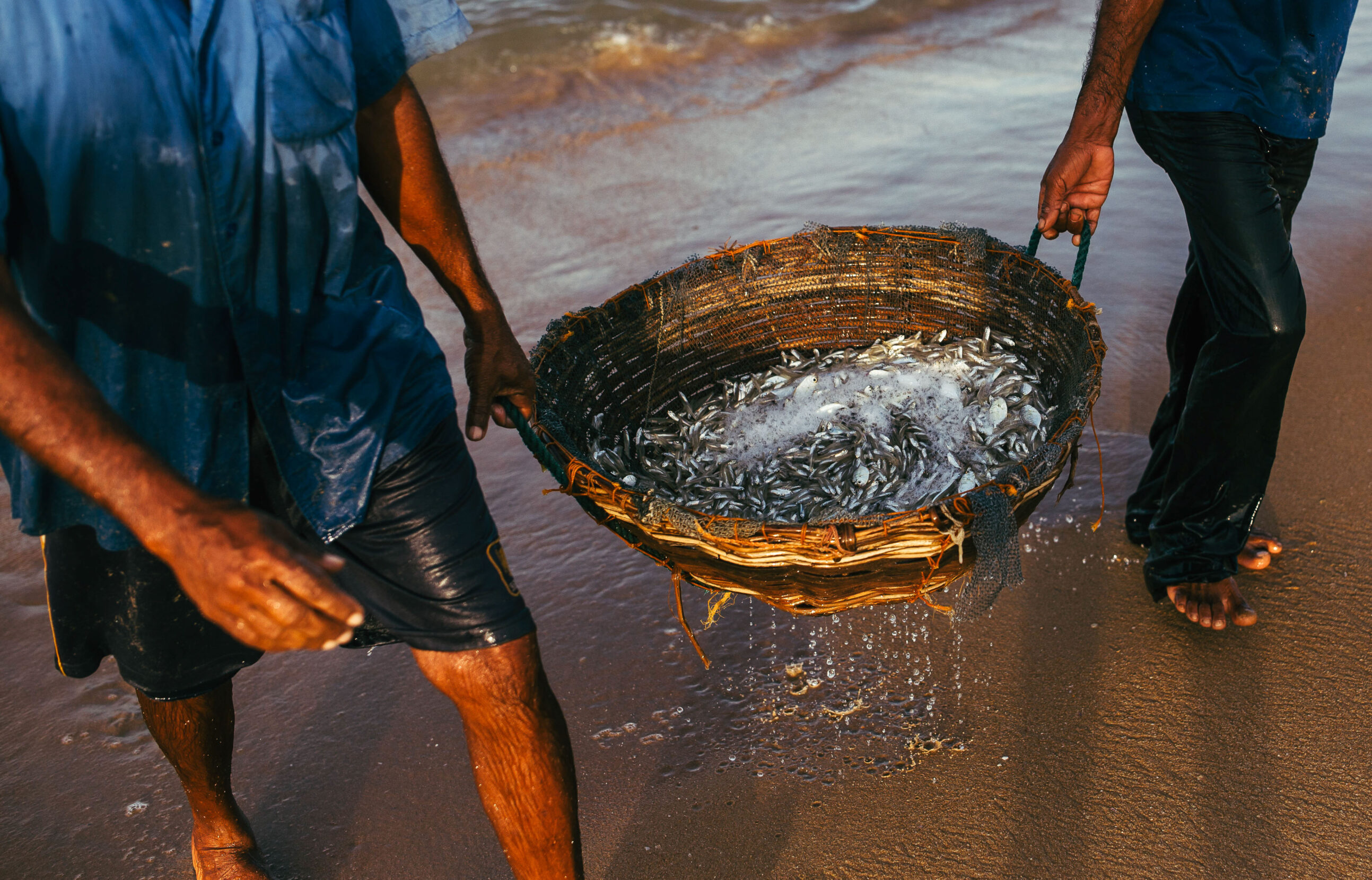
Many see fishing as an inherent violation of one of Buddhism’s main tenets: to never kill. Photo: Kang-Chun Cheng.
Colonial influences have aggravated tensions over the years. The Tamil minority — just 15% of the population, as opposed to the 74% who are Sinhalese — were overtly favored by the British relative to their Sinhalese counterparts. For instance, English language schools were established in Tamil-heavy areas, where the British allocated superior business opportunities.
But with the nation’s independence in 1948, the Sinhalese took the upper hand. They passed discriminatory policies disenfranchising Tamils as part of their political retribution. In both groups’ efforts to reclaim dignity and power stolen by Westerners, a 26-year civil war raged on, ending in 2009. In the lives of Sri Lankans, the war’s wounds are still fresh.
Yet researchers like Sandaruwan are focusing on more than the challenges fishermen face. They look at how these communities adapt, how their generational fishing practices are changing, and how, through creative means, the heart of their culture can persist.
Because their tradition, like the world in which it takes place, isn’t static.
~~
Negombo, home to 137,000 people, is called “Little Rome” due to its Roman Catholic majority — Catholicism is the prevailing form of Christianity in Sri Lanka. At least 40 churches and chapels, many built in the elaborate Baroque and Renaissance styles, are dotted across the city, where the infrastructure is otherwise far less grand.
During my first days here, I loved exploring the quieter streets, stumbling upon temples heavy with marigolds and packed to the brim with ornate sculptures. Here, sidewalks have been built around the tangled roots of ancient java fig trees.
Walking down the street after a delicious meal of kottu — a local dish made of shredded roti, curry, and egg, served in an enormous cone of newspaper — I notice how shrines of the Virgin Mary seem to proliferate every corner. There is a cultural and religious melding in these shrines: fresh coconuts and hibiscus flowers compliment the otherwise classic Catholic iconography.
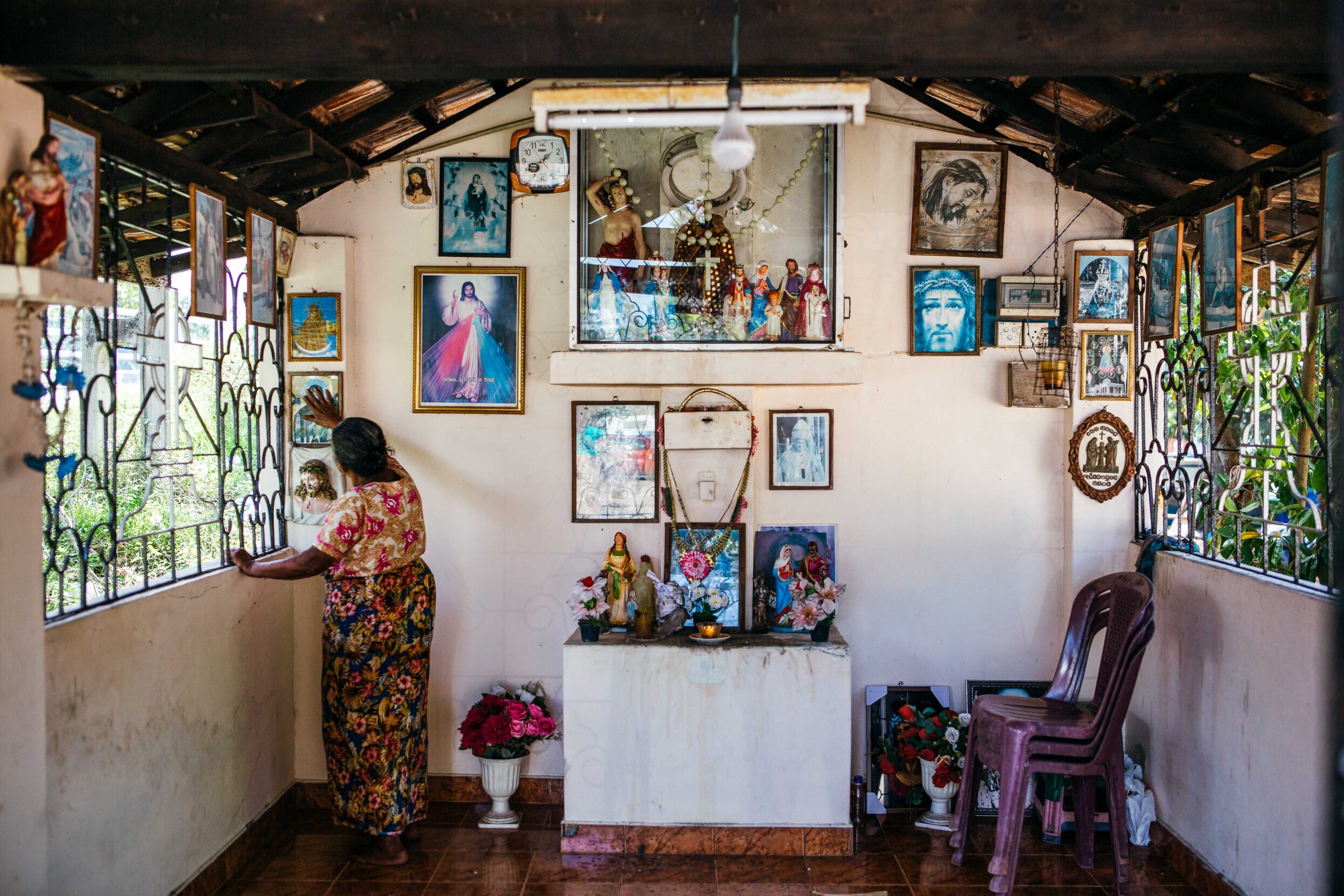
Although more than half of Sri Lankans practice Buddhism, fishing communities are often majority Catholic. Here, a woman attends to her collection of religious objects, including statues of the Virgin Mary and images of Jesus Christ. Photo: Kang-Chun Cheng.
Christianity arrived on the island through European settlers: Portuguese, Dutch, and British missionaries alighting on the western coast noticed that fishermen were particularly amenable to embracing a new religion, one that could offer structure and moral guidance yet did not denigrate their way of making a living. In contrast, agriculturalists inland who lived off of vegetables and grains proved far less responsive to the conversion attempts — but also were not often the focus of said attempts. Regardless, the geographic correlation is unequivocal, Sandaruwan told me.
The few days a month when he is not hard at work on the ocean, Marcus — the fisherman I met while strolling the beach — attends a Catholic church here in downtown Negombo with his family. The congregation is an amalgamation of Sri Lankans from all walks of life. In the church’s grand, hallowed halls, before shrines that have endured wars and unspeakable suffering, worshippers find some respite from their socially imposed hierarchies. Mass begins at 5 a.m., but it does not seem so early for those who are used to going to work just after midnight.
~~
The Negombo fish market opens as early as 4:30 a.m., welcoming the catches from overnight. I arrive at dusk, and the open-air stalls are still bustling. Discerning shoppers alight from their motorbikes, strolling through the market to survey their options. In the back, there is a butcher’s block where young men skillfully scale and debone fish into filets as the buyers please. Translucent scales fly with each whack and thud from the cleaver, punctuated by the slippery sound of another fish flopping onto the wooden chopping boards.
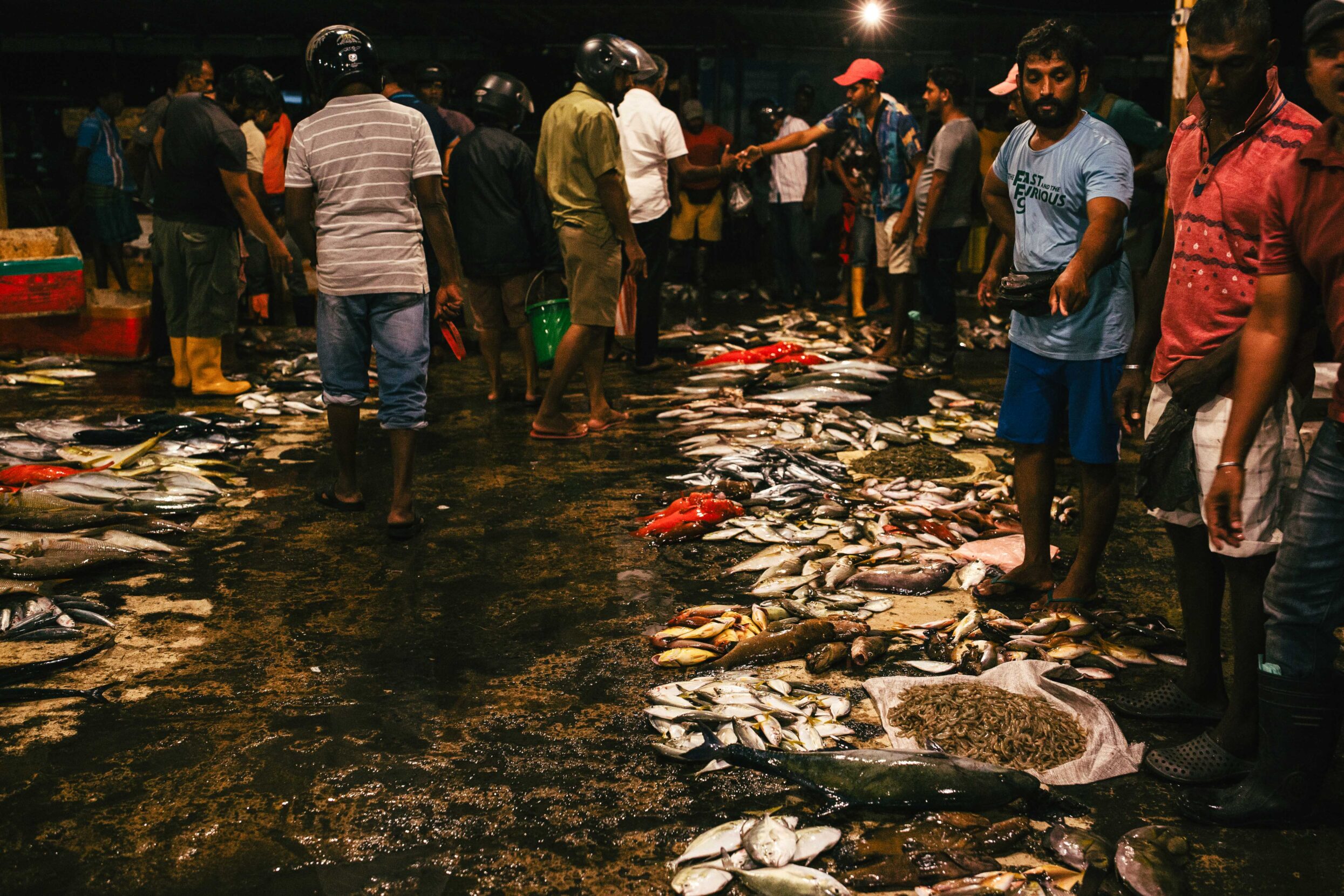
The Negombo fish market is open from early morning to evening. Shoppers arriving on motorbikes survey the variety of fish and other seafood. Photo: Kang-Chun Cheng.
~~
Babarandage don Sarath Appuham, a 59-year-old fisherman, has been part of the same beach seine in Negombo Lagoon since his youth. He’s just returned home for the evening, saltwater dripping from his clothing, sand coating his legs. We gather on his cozy front porch with Aruna Maheepala, a socioeconomic and aquatic resources senior scientist with NARA. Neighboring kids skip around the sandy path adjacent to their home, peering curiously through the fence.
Appuham’s wife brings out some seats and glasses of soda. Lovely hibiscus flowers lean over the garden railing, swaying in the gentle sea breeze.
“He doesn’t mind living in a small home,” Maheepala translates for me from Sinhalese, “He’s proud of his work as a fisherman.”
This is what Sandaruwan had explained to me previously regarding these artisanal fishermen’s values: the prioritization of agency and freedom over material goods. “Their work may be risky and unpredictable, and many outsiders looking in may wonder why they choose to continue such precarious livelihoods. But being able to be out on the water, fish when they want –– that’s what they value in terms of well-being.”
This is what the well-being framework of Sandaruwan’s research has uncovered. Fishermen yearn for this agency. They’re proud of their self-sustaining livelihood: how it allows them to enjoy the open water, taking the successive calmness of smooth waters and life-threatening storms all in stride. And their communities are tight-knit from sharing experiences, discriminations, and economic burdens together, worshiping, at times, in the same churches or cathedrals.
“They don’t want a ‘better job’ in the conventional sense,” says Sandaruwan. Office jobs are viewed as tedious and repressive.
Maheepala sketches out in my notebook how Appuham’s beach seine splits costs and catches to help me visualize the system. It’s more complex than I imagined, the parameters of each week ever-shifting: how many fish are caught, how many years one has worked with that beach seine, whether there are any group debts to pay off. Appuham’s wife chimes in often. “She’s in charge of the household budget,” chuckles Maheepala.
I can tell their daughter, probably around the age of 15, is their pride and joy. She moves fluidly, like someone used to being in water, and perches herself on the railing of the porch, listening in. It seems unlikely that Appuham and his wife would want her subject to the whims of such a volatile livelihood as the seas are depleted, even though it’s what they’ve chosen for themselves. But I don’t want to disrupt this moment of calm with such a question.
As we get up to leave, Appuham hands a fish to Maheepala — something that looks like a mackerel. It is part of Appuham’s share of the catch from the day, and he won’t take no for an answer.
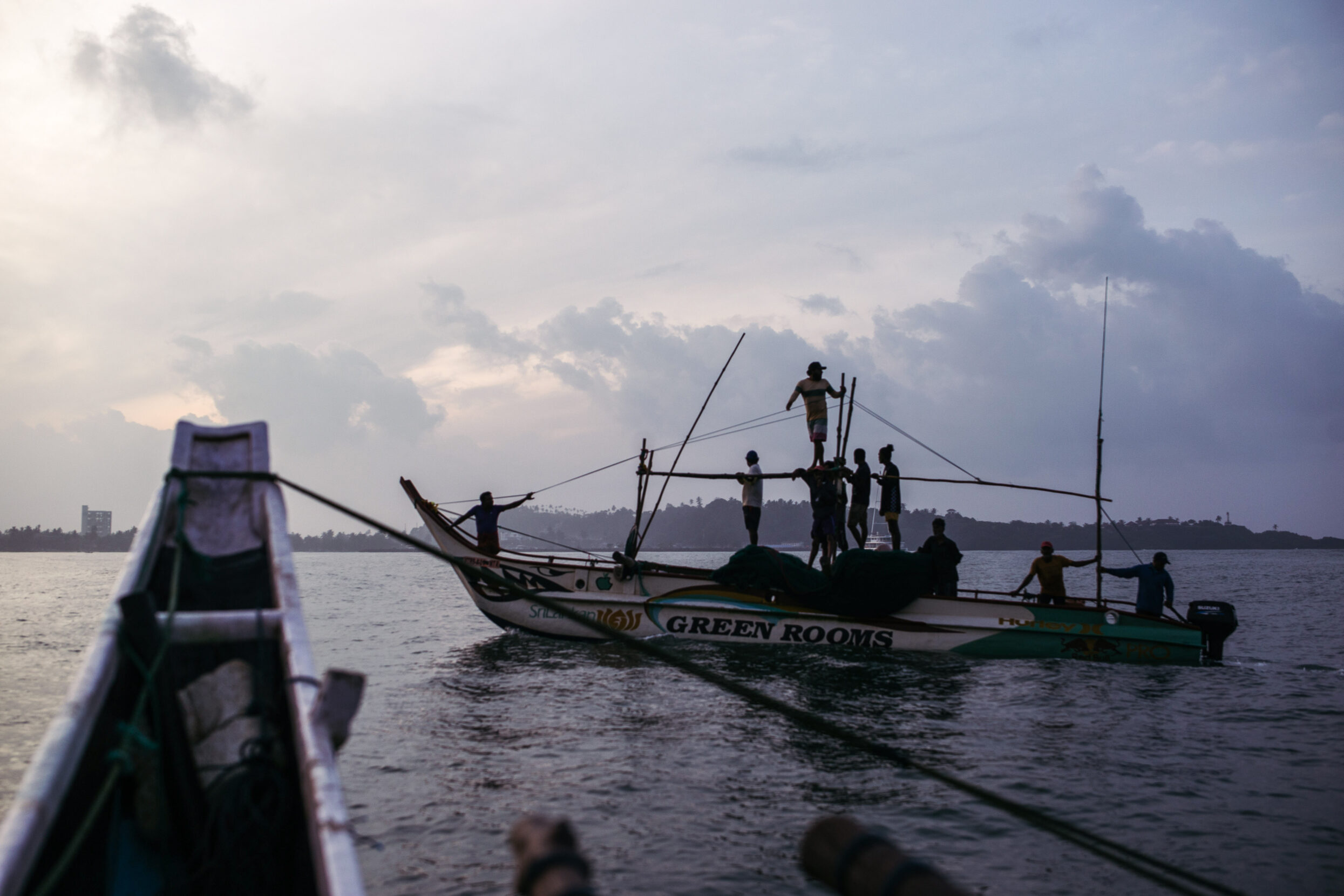
Vallams, boats akin to large canoes, have been used by Sri Lankan seine fishermen for generations. More and more, fully manual beach seines are becoming a rarity as mechanization becomes widespread. Photo: Kang-Chun Cheng.
~~
The whirl of the tractor and the unforgiving sun make for a heady experience. Gulls swirl above the water where half a dozen fishermen have cast their seine. 32-year-old Kasun has fished for over half of his life. In 2017, he bought two tractors to aid his work. He tells me that finding workers causes him endless woes.
“For each day I fish, I hire 12 people from Kepungoda village [30 km away], where I live,” he explains.
Sometimes, he makes more than the 20,000 rupees (roughly $63 USD) it costs for the lorry hire, petrol, and day wages — sometimes, he doesn’t. On this day, his crew barely reels in anything. Most go home empty-handed.
Their gleaming bodies squirm in the bright morning light, the last dance of their lives.
It is increasingly rare to witness a beach seine that is entirely manual, says Santhalingam Thanusanth, another fisheries biologist from NARA. Many artisanal fishermen are keen on new adaptations, believing they should improve their catch rates and minimize manual labor to keep up with the times. It’s a matter of survival. Folks like Kasun have incorporated tractor winching into their process just to stay afloat, but the cost of petrol might prove to be their downfall.
Tractors enable beach seine fishermen to cast their net three to four times a day, compared to just once or twice when it’s all done by hand. But machines always have to eat. “Manual labor is a flexible cost, but fuel for the tractor is fixed,” says Kasun.
“[Technological advancement] automatically creates fishing competition between those using traditional methods versus new techniques,” says Thanusanth, which may force people to gravitate toward advanced methods. Research agencies like NARA are there to regulate developments and ultimately encourage hybrid practices with minimal impact on the environment and biodiversity.
“We need to accept that adaptations in fisheries, up to a certain level, ensure long term-sustainability. Mechanized beach seine falls under this point of view,” the biologist continues. “The good thing is that traditional techniques in beach seine fishery are still under operation in most of the sites along Sri Lanka, even with the invasion of mechanization.”
In the face of overwhelming changes, it can be easy to believe that cultures are fading or being eradicated. Yet the very dimensions of these fishermen’s identities — like all human cultures –– lie on a spectrum and are always in flux. They always have been.

A group of fishermen work together to bring the seine ashore. For these men, their livelihood is rooted in tradition. But tradition is ever-changing. Photo: Kang-Chun Cheng.
~~
On one of my last evenings in Negombo, I stand across one of the roadside shrines at dusk. Over the course of 10 minutes, several people stop before the Virgin Mary, touching the glass case containing her sculpture with adoration. Whether it is for blessings or absolution, only they know.
I consider how the foundations for such rituals originated more than 3,000 miles away — from lands diametric to this tropical island. Somehow, this religion managed to find a home here, now forever a piece of Sri Lanka’s ever-shifting, amalgamated identities.
One man kneels before the shrine for some time, caught in his thoughts, hands clasped. I catch myself staring, but he is entranced in his own reverie. After some time, he stands up to resume his walk home, and I hope his prayers bring him fortitude.
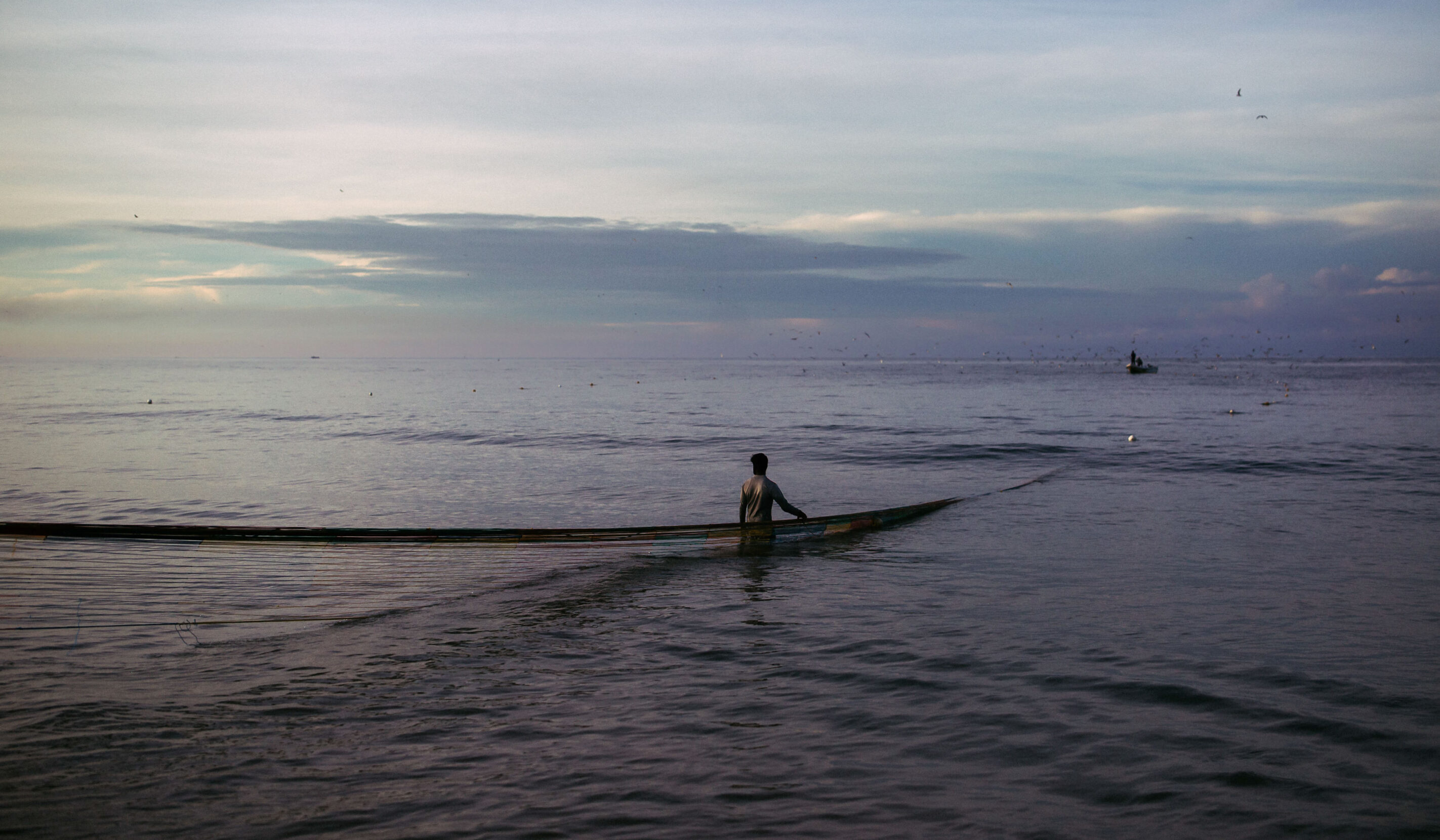
A fisherman holds the seine as he wades into the water, looking out to sea for guidance. Photo: Kang-Chun Cheng.
Kang-Chun Cheng
Kang-Chun (KC) Cheng is an environmental photojournalist based in Nairobi, Kenya, reporting on land-use conflicts, the impact of climate change and technology on Indigenous communities, and China-Africa relations.


